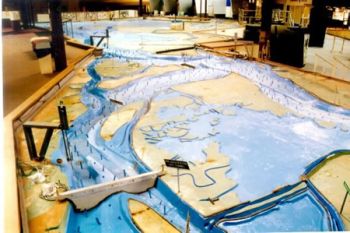Three-Dimensional Hydraulic Models: Difference between revisions
No edit summary |
No edit summary |
||
| Line 1: | Line 1: | ||
__NOTOC__ | __NOTOC__ | ||
[[Category:Hydraulics]] | |||
---- | ---- | ||
<!-- Delete any sections that are not necessary to your topic. Add pictures/sections as needed --> | <!-- Delete any sections that are not necessary to your topic. Add pictures/sections as needed --> | ||
| Line 14: | Line 15: | ||
}} | }} | ||
Three-dimensional hydraulic models are typically used in the study of rapidly-varied flow that occurs along a spillway or bridge pier or in the study of the effects of turbulence and irregular flow geometries on various closed conduit components such as valves or flow meters. As a result of the uncertainties in predicting the effects of rapidly-varied flow by using either one- or two-dimensional hydraulic modeling methods, three-dimensional models reduce the uncertainty in this type of turbulent flow and help to achieve a greater level of optimization for a hydraulic design in an engineering project. There are two types of three-dimensional hydraulic models that can be used depending on the level of analysis and detail required by the study and available funds: | Three-dimensional hydraulic models are typically used in the study of rapidly-varied flow that occurs along a spillway or bridge pier or in the study of the effects of turbulence and irregular flow geometries on various closed conduit components such as valves or flow meters. As a result of the uncertainties in predicting the effects of rapidly-varied flow by using either one- or two-dimensional hydraulic modeling methods, three-dimensional models reduce the uncertainty in this type of turbulent flow and help to achieve a greater level of optimization for a hydraulic design in an [[engineering]] project. There are two types of three-dimensional hydraulic models that can be used depending on the level of analysis and detail required by the study and available funds: | ||
* [[Physical Models]] | * [[Physical Models]] | ||
Revision as of 02:21, 18 November 2022

|
| The USACE Bay Model is one of the most famous and most complex physical hydraulic models ever built. While it was once used for scientific research, it is now a tourist attraction. (USACE) |
Three-dimensional hydraulic models are typically used in the study of rapidly-varied flow that occurs along a spillway or bridge pier or in the study of the effects of turbulence and irregular flow geometries on various closed conduit components such as valves or flow meters. As a result of the uncertainties in predicting the effects of rapidly-varied flow by using either one- or two-dimensional hydraulic modeling methods, three-dimensional models reduce the uncertainty in this type of turbulent flow and help to achieve a greater level of optimization for a hydraulic design in an engineering project. There are two types of three-dimensional hydraulic models that can be used depending on the level of analysis and detail required by the study and available funds:
Citations:
Revision ID: 4290
Revision Date: 11/18/2022
